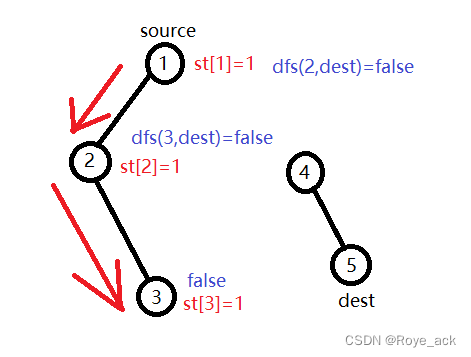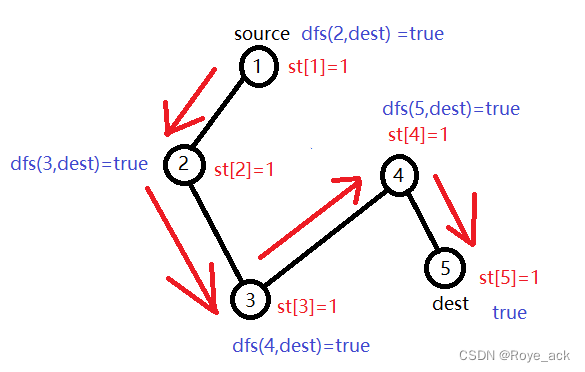目录
1、bfs - 邻接矩阵
- 让源点source入队 取队头遍历未标记的邻接节点并入队
- 如果队伍里有dest目标节点 说明dest被遍历到 则return true
class Solution {
public:
static const int N=2*1e5;
bool st[N]={false};
bool validPath(int n, vector<vector<int>>& edges, int source, int dest)
{
vector<vector<int>> g(n);
//vector<bool> st(n,false);
for(vector<int>& x:edges)
{
int a=x[0],b=x[1];
g[a].push_back(b);
g[b].push_back(a);
}
queue<int> q;
q.push(source);
st[source]=true;
while(!q.empty())
{
int t=q.front();
q.pop();
if(t==dest) return true;
for(int i=0;i<g[t].size();i++)
if(!st[g[t][i]])
{
st[g[t][i]]=true;
q.push(g[t][i]);
}
}
return false;
}
};?2、dfs - 邻接表


- 首先从顶点source 开始遍历并进行递归搜索
- 搜索时每次访问一个顶点next时,如果next==dest则该层返回true 不用继续遍历dest相邻的节点
- 否则将该顶点设为已访问,并递归访问与next相邻且未访问的顶点
- 如果搜到的最后一个点不能找到dest 则层层返回false
- 如果搜到一个点能找到dest 则层层返回true
class Solution {
public:
static const int N=2*1e5+10;
int h[N],e[N<<1],ne[N<<1],idx;
bool st[N]={false};
void add(int a,int b)
{
e[idx]=b,ne[idx]=h[a],h[a]=idx++;
}
bool dfs(int u,int dest)
{
st[u]=true;
if(u==dest) return true;
for(int i=h[u];~i;i=ne[i])
{
int t=e[i];
if(!st[t]&&dfs(t,dest))
{
return true;
}
}
return false;
}
bool validPath(int n, vector<vector<int>>& edges, int source, int dest)
{
memset(h,-1,sizeof h);
for(vector<int> &x:edges)
{
int a=x[0],b=x[1];
add(a,b),add(b,a);
}
return dfs(source,dest);
}
};?3、并查集
find 查询a和b是否在一个集合内
unite 如果a和b不在一个集合 则f[a]=b 给a认个祖宗b 也就是把ab放一个集合内
class Solution {
public:
static const int N=2*1e5+10;
int f[N];
int find(int x)
{
if(x!=f[x]) f[x]=find(f[x]);
return f[x];
}
void unite(int x,int y)
{
int a=find(x),b=find(y);
if(a!=b) f[a]=b;
}
bool validPath(int n, vector<vector<int>>& edges, int source, int dest)
{
for(int i=1;i<=n;i++) f[i]=i;
for(vector<int> &x:edges)
{
int a=x[0],b=x[1];
unite(a,b);
}
return find(source)==find(dest);
}
};?